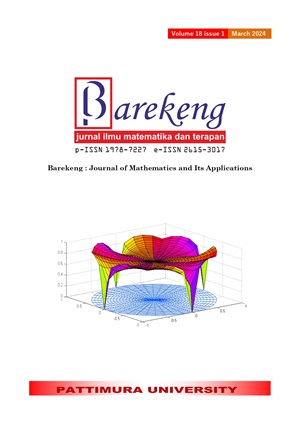ESTIMATION OF GEOGRAPHICALLY WEIGHTED PANEL REGRESSION MODEL WITH BISQUARE KERNEL WEIGHTING FUNCTION ON PERCENTAGE OF STUNTING TODDLERS IN INDONESIA
Abstract
Stunting is a condition of failure to thrive in children under five years old due to chronic malnutrition. Efforts that can be made to reduce the incidence of stunting in Indonesia are to identify factors that are thought to affect the incidence of stunting in Indonesia. The analysis methods used in this study are the global Fixed Effect Model (FEM) and the local Geographically Weighted Panel Regression (GWPR) model. FEM is a global regression model that assumes that each individual's model has a different intercept value. While GWPR is a local regression model from FEM that considers aspects of geographic location, by repeating data at each observation location, different times, and using spatial data. The weighting function used in this study is fixed bisquare and adaptive bisquare. This study aims to obtain a GWPR model on the percentage of stunting toddlers in Indonesia in 2019 until 2022 with independent variables, namely the percentage of children receiving exclusive breastfeeding , the percentage of households that have access to proper sanitation , the average per capita health expenditure of the population for a month , the average length of schooling for women , and the number of poor people . The variables are obtained from Statistics Indonesia (BPS) and Study of Indonesia’s Nutritional Status (SSGI). The results showed that the best weighting function, namely adaptive bisquare with a CV value of 264.80.
Downloads
References
Sifriyani, Kapita Selekta Statistika Spasial Spatio-Temporal Models. Indonesia: Mulawarman University Press, 2023.
Z. Mar'ah, and Sifriyani, “GEOGRAPHICALLY WEIGHTED PANEL REGRESSION (GWPR) FOR COVID-19 CASE IN INDONESIA,” BAREKENG: J. Math. & App., vol. 17, iss. 2, pp. 0879–0886, June, 2023.
V. S. Puspita and T. S. Yanti, “Penerapan Analisis Regresi Spasial untuk Menentukan Faktor-Faktor Penyebab Stunting di Nusa Tenggara Barat Tahun 2021,” Bandung Conference Series: Statistics, vol. 2, no. 2, pp. 245–253, 2022.
A. Murwiati, “Deteksi Spatial Dependence terhadap Fixed Effects Model Prevalensi Stunting,” J. Ekon. Pembang. Unila, vol. 1, no. 1, pp. 21–30, 2021.
M. G. L. Bele, E. M. P. Hermanto and F. Fitriani, “Pemodelan Geographically Weighted Regression pada Kasus Stunting di Provinsi Nusa Tenggara Timur Tahun 2020,” J. Stat. dan Apl., vol. 6, no. 2, pp. 179–191, 2022.
A. Widarjono, Ekonometrika Teori dan Aplikasi. Yogyakarta: Ekonisia, 2007.
D. Rosadi, Analisis Ekonometrika dan Runtun Waktu Terapan dengan R. Yogyakarta: Andi, 2011.
D. N. Gujarati, Ekonometri Dasar. Terjemahan: Sumarno Zain. Jakarta: Erlangga, 2003.
J. M. Wooldridge, Econometrics Analysis of Cross-Section and Panel Data. London: MIT Press, 2002.
Setiawan and D.E. Kusrini, Ekonometrika. Yogyakarta: Andi, 2010.
D. N. Gujarati, Ekonometika Dasar. Jakarta: Erlangga, 2006.
Sifriyani et al., “A Spatio-Temporal Description of Covid-19 Cases in East Borneo using Improved Geographically And Temporally Weighted Regression (I-GTWR),” Commun. Math. Biol. Neurosci., vol. 2022, pp. 1–22, 2022.
Sifriyani, M. Rasjid, D. Rosadi, S. Anwar, R. D. Wahyuni, and S. Jalaluddin, “Spatial-Temporal Epidemiology of COVID-19 Using a Geographically and Temporally Weighted Regression Model,” Symmetry (Basel)., vol. 14, no. 4, pp. 742, 2022, doi: https://doi.org/10.3390/sym14040742.
A. S. Fotheringham, C. Brunsdon, and M. Charlton, Geographically Weighted Regression: The Analysis of Spatially Varying Relationships. Chichester: Wiley, 2002.
S. Sifriyani, I. Mandang, F. D. T. Amijaya, and R. Ruslan, “Developing Geographically Weighted Panel Regression Model For Spatio-Temporal Analysis Of Covid-19 Positive Cases In Kalimantan, Indonesia,” J. Southwest Jiaotong Univ., vol. 57, no. 3, 2022.
F. Bruna and D. Yu, “Geographically Weighted Panel Regression,” XI Galician Congr. Stat. Oper. Res., pp. 1–23, 2013.
S. Sifriyani, I. Mandang, and F. D. T. Amijaya, “Geographically temporally weighted regression model for GIS mapping of influence COVID-19 in East Kalimantan,” in AIP Conf. Proc., vol. 2668, pp. 070012, 2022.
R. Cai, D. Yu, and M. Oppenheimer, “Estimating the Spatially Varying Responses of Corn Yields to Weather Variations Using Geographically Weighted Panel Regression,” J. Agric. Resour. Econ., vol. 39, no. 2, 2014.
H. A. D. Boo and J. E. Harding, “The developmental origins of adult disease,” Aust. New Zeal. J. Od Obs. Gyneacology, vol. 46, pp. 4–14, 2006.
Badan Pusat Statistik (BPS), Profil Kesehatan Ibu dan Anak. Jakarta: Badan Pusat Statistik, 2022.
Copyright (c) 2024 Asnita Asnita, Sifriyani Sifriyani, Meirinda Fauziyah

This work is licensed under a Creative Commons Attribution-ShareAlike 4.0 International License.
Authors who publish with this Journal agree to the following terms:
- Author retain copyright and grant the journal right of first publication with the work simultaneously licensed under a creative commons attribution license that allow others to share the work within an acknowledgement of the work’s authorship and initial publication of this journal.
- Authors are able to enter into separate, additional contractual arrangement for the non-exclusive distribution of the journal’s published version of the work (e.g. acknowledgement of its initial publication in this journal).
- Authors are permitted and encouraged to post their work online (e.g. in institutional repositories or on their websites) prior to and during the submission process, as it can lead to productive exchanges, as well as earlier and greater citation of published works.






1.gif)



